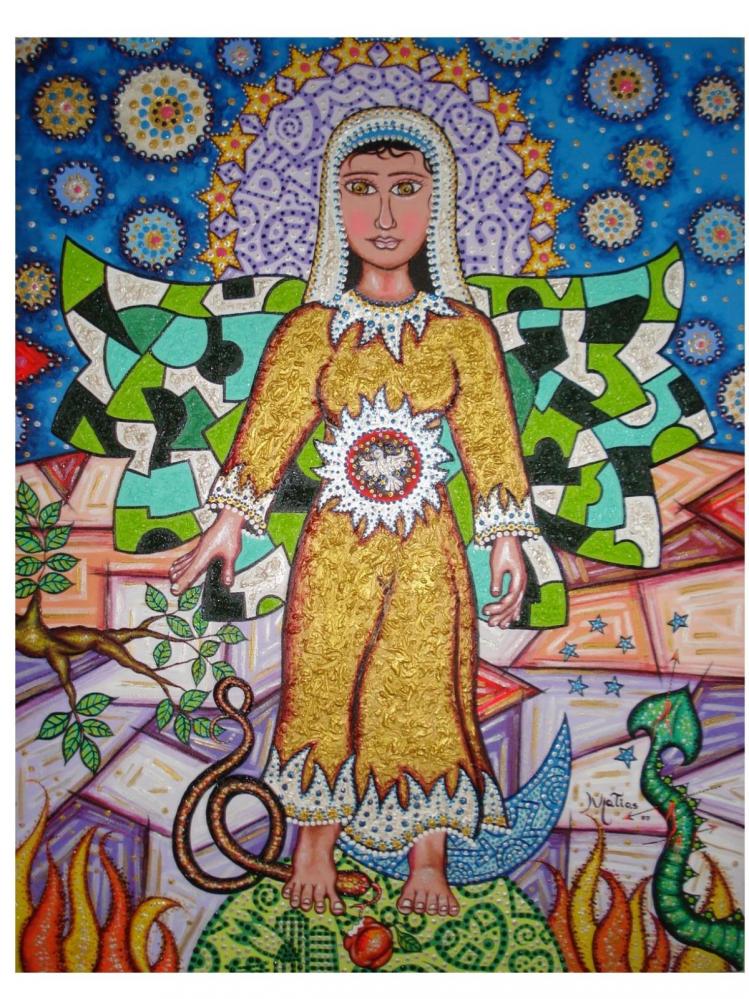
Last Wednesday night, members of the University of Dayton community participated in Las Posadas. Las Posadas incarnates a backstory for the Lukan passage, “And she gave birth to her firstborn son and wrapped him in bands of cloth, and laid him in a manger, because there was no place for them in the inn” (2:7). A simple translation of the words sung on behalf of Mary by Joseph and all pilgrims at three houses follows:
In the name of heaven, I ask for your assistance in respite for my beloved wife who cannot walk. She is the queen of heaven and is asking for shelter for one night. Mary, my wife, will be the mother of the Incarnate Word.
In this popular practice, Mary and all are turned away at the first three houses. At the fourth house, all are welcomed in for a large party. Although Mary has no speaking role during the celebration of Las Posadas, we experience in this event how Mary calls us to rejoice.
Many times when we arrive at Gaudete Sunday and light the pink candle of the Advent wreath, we focus on anticipation of the arrival of Jesus. We are excited about being with loved ones. Yet the etymology of “rejoice” also calls us to pay attention to more. “Re” can be given the root meaning to express intense force. “Joy” of course means delight, bliss, and pleasure (including erotic pleasure). All of these meanings of “joy” are linked to our sensuality.
We experience the world as sensual beings. And as sensual beings, we’re also complex—we can simultaneously label sensual stimulation as positive and negative. The sensuality we see in Mary, her tiredness and inability to walk because of her pregnancy, is the root of a gathering for Las Posadas. Hitting a piñata during the posada celebration is a symbol of beating against the seven deadly sins. Swinging at a piñata can bring pleasure and relieve stress. It can inspire courage—the kind needed to risk looking like a fool by missing entirely. And then there’s the sometimes painful sensation that comes with missing the piñata and whacking the tree.
To rejoice means to be in strong force with all of that sensuality and all of our sensual existence. In preparing to write this piece, I asked some companions in the Marianist family and Marianist education for a few words to share about Mary. “Mary is one, who in intimate proximity, accompanies each of us,” said Caitlin Cipolla-McCulloch. “Mary is an incredibly tangible role model who exemplifies the brilliance of bravery and conviction of faith lived out in the normalcy of daily life,” Tiffany Nascimento said. “Mary, the only Mother of God, is a real person whose faith strengthened her,” said Fr. Michael Davis.
“Bearing Christ into the world, Mary was attentive to him for the entirety of his earthly life, witnessing his passion and death,” said Michael Romero. “Mary is a model of extreme openness to God,” Tom Pieper said. And, from Laura Leming: “Mary is strong. She risked her life to say yes to God. She was the mother of one executed by the state.”
These comments connect to the Feast of the Immaculate Conception, which we celebrated this past week. Because of Mary’s Immaculate Conception, Mary and Jesus have a sinless relationship. However, while sinless, it is not a life without pain and suffering. Our Catholic tradition does not shy away from tying Mary of the Immaculate Conception with Mary of Sorrows. Through Mary, our Catholic tradition leans into the notion of Gaudete—rejoicing—as an expression of intense sensual force, of all that Mary’s human body experiences, especially since Catholics also believe that Mary was assumed body and soul into heaven. Therefore, we must think that as Mother of the Church (declared by Lumen gentium, chapter eight), Mary continues to accompany us in all that our human bodies experience.
Mary accompanies us and we accompany Mary in full, intimate, sensual existence. We struggle through life and face injustices just as Christian scriptures tell us the stories of Mary’s struggle. Faith, as Mary’s faithful response to God’s invitation, roots our rejoicing, our intense force of sensual existence. And faith, like Mary’s “yes,” often calls us to unexpected suffering while creating space for deeper relationship, which is the root of the Incarnation, the reason our triune God chose to become human.
A quick translation of my favorite Marian song, “Santa Maria del Camino,” reminds us of these many connections between rejoicing, Mary, and our lives:
As you walk through life, you will never be alone. Holy Mary accompanies.
Come walk with us, Holy Mary.
Although some will say that nothing will ever change, struggle for a new world, struggle for the truth
Come walk with us, Holy Mary.
If people go through the world isolated, never deny reaching out your hand because someone is always with you.
Come walk with us, Holy Mary.
Even if your steps seem futile, create paths, others will follow.
Come walk with us, Holy Mary.
Christians believe Mary’s faith opened many paths for a world in better relationship with an Incarnational God, for understanding the struggle to make it through the day, to heal, to change as part of the intense force of human sensual existence. Rejoice, for we were created in this way.